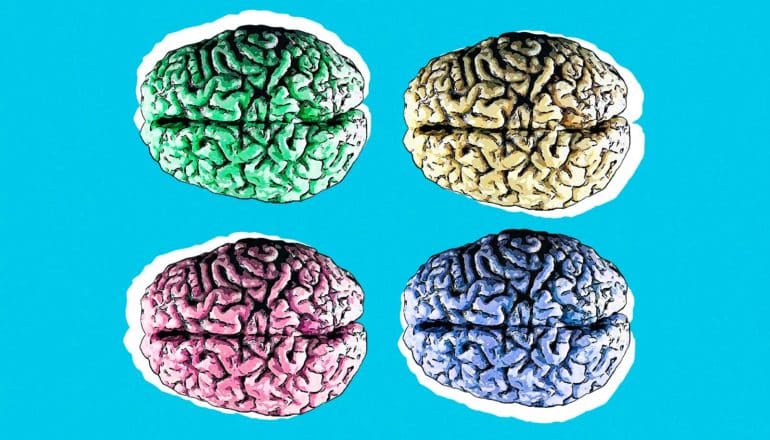
Lab-grown brain tumor organoids developed from a patient’s own glioblastoma, the most aggressive and common form of brain cancer, may hold the answers on how to best treat it, researchers report.
A new study in Cell shows how glioblastoma organoids could serve as effective models to rapidly test personalized treatment strategies.
Glioblastoma multiforme (GBM) remains the most difficult of all brain cancers to study and treat, largely because of tumor heterogeneity. Treatment approaches, like surgery, radiation, and chemotherapy, along with newer personalized cellular therapies, have proven to slow tumor growth and keep patients disease-free for some period of time. However, a cure remains elusive.
“While we’ve made important strides in glioblastoma research, preclinical and clinical challenges persist, keeping us from getting closer to more effective treatments,” says senior author Hongjun Song, professor of neuroscience in the Perelman School of Medicine at the University of Pennsylvania.
“One hurdle is the ability to recapitulate the tumor to not only better understand its complex characteristics, but also to determine what therapies post-surgery can fight it in a timelier manner.”
Faster growth
Lab-grown brain organoids—derived from human pluripotent stem cells or patient tissues and grown to a size no bigger than a pea—can recapitulate important genetic composition, brain cell type heterogeneity, and architecture, for example.
These models allow researchers to recreate key features of patients’ diseased brains to help paint a clearer picture of their cancer, and then allow them to explore ways to best attack it. What makes organoids so attractive in GBM is timing and the ability to maintain cell type and genetic heterogeneity.
While existing in vitro models have added to researchers’ understanding of the biological mechanisms underlying the cancer, they have limitations. Unlike other models, which need more time to exhibit gene expression and other histological features that more closely represent the tumor, brain tumor organoids the research group developed grow into use much more rapidly.
That’s important because current treatment regimens are typically initiated one month following surgery, so having a road map sooner offers more advantages.
Personalized treatments for glioblastoma
In the new study, the researchers removed fresh tumor specimens from 52 patients to “grow” corresponding tumor organoids in the lab. The overall success rate for generating glioblastoma organoids (GBOs) was 91.4%, with 66.7% of tumors expressing the IDH1 mutation, and 75% for recurrent tumors, within two weeks. Researchers can also biobank these tumor glioblastoma organoids and recover them later for analyses.
The researchers also performed genetic, histological, molecular analyses in 12 patients to establish that these new GBOs had largely retained features from the primary tumor in the patient.
They then successfully transplanted eight GBO samples into adult mouse brains, which displayed rapid and aggressive infiltration of cancer cells and maintained key mutation expression up to three months later. Importantly, they observed a major hallmark of GBM—the infiltration of tumor cells into the surrounding brain tissue—in the mouse models.
To mimic post-surgery treatments, the researchers subjected GBOs to standard-of-care and targeted therapies, including drugs from clinical trials and chimeric antigen receptor T (CAR-T) cell immunotherapy.
For each treatment, researchers showed that the organoid responses are different and effectiveness correlates to their genetic mutations in patient tumors. This model opens the possibility for future clinical trials for personalized treatment based on individual patient tumor responses to various different drugs.
Notably, the researchers observed a benefit in the organoids treated with CAR T therapies, which they had used in ongoing clinical trials to target the EGFRvIII mutation, a driver of the disease. In six GBOs, the researchers showed specific effect to patient GBOs with the EGFRvIII mutation with an expansion of CAR T cells and reduction in EGFRvIII expressing cells.
Looking to the future
“These results highlight the potential for testing and treating glioblastomas with a personalized approach. The ultimate goal is to work towards a future where we can study a patient’s organoid and test which CAR T cell is going to be the best against their tumor, in real time,” O’Rourke says.
“A shorter-term goal, given the heterogeneity of glioblastomas, is that in vitro testing of various therapeutic options may also help refine patient enrollment in clinical trials, by more accurately defining mutations and selecting the appropriate, available targeted therapies for each.”
Support for this work came partially from the Glioblastoma Translational Center of Excellence at the Abramson Cancer Center, the National Institutes of Health, the Sheldon G. Adelson Medical Research Foundation, a Blavatnik Family Fellowship in Biomedical Research, and a Hearst Foundation Fellowship.
Source: University of Pennsylvania
The post Brain tumor organoids hint at how to best treat glioblastoma appeared first on Futurity.
from Futurity https://ift.tt/2SwWHn1
No comments:
Post a Comment